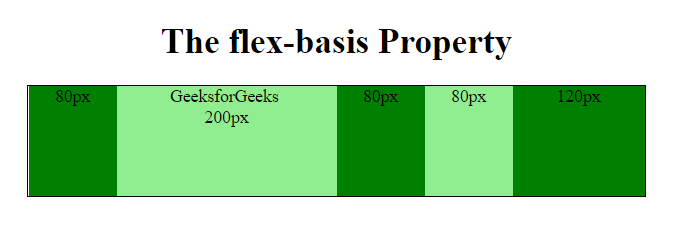CSS flex-basis Property
Last Updated :
24 Apr, 2024
The flex-basis property in CSS is used to specify the initial size of the flexible item. The flex property is not used if the element is not flexible item.
Syntax:
flex-basis: number | auto | initial | inherit;
Default Value:
Property Values:
Property Value
| Description
|
|---|
number
| It is a length unit that define the initial length of that item.
|
auto
| It is the default value, if the length is not specified the length will be according to it’s content.
|
initial
| It sets the property to it’s default value.
|
inherit
| It specifies that a property should inherit its value from its parent element.
|
Different Examples of CSS Flex Basis Property
Example 1: In this example, we are using the CSS flex basis property.
html
<!DOCTYPE html>
<html>
<head>
<style>
.Geeks {
width: 385px;
height: 70px;
display: flex;
}
.Geeks div {
flex-grow: 0;
flex-shrink: 0;
flex-basis: 80px;
/* For Safari 6.1 and above browsers */
-webkit-flex-grow: 0;
-webkit-flex-shrink: 0;
-webkit-flex-basis: 80px;
}
.Geeks div:nth-of-type(2) {
flex-basis: 50%;
}
.Geeks div:nth-of-type(3) {
flex-basis: auto;
}
.Geeks div:nth-of-type(4) {
flex-basis: initial;
}
.Geeks div:nth-of-type(5) {
flex-basis: inherit;
}
</style>
</head>
<body>
<center>
<h1>
The flex-basis Property
</h1>
<div class = "Geeks">
<div style = "background-color:green;">
number 80px
</div>
<div style = "background-color:lightgreen;">
percentage
</div>
<div style = "background-color:green;">
auto
</div>
<div style = "background-color:lightgreen;">
initial
</div>
<div style = "background-color:green;">
inherit
</div>
</div>
</center>
</body>
</html>
Output:

Example 2: In this example, we are using the CSS flex basis property
html
<!DOCTYPE html>
<html>
<head>
<style>
.Geeks {
width: 560px;
height: 100px;
border: 1px solid black;
display: flex;
}
.Geeks div {
flex-grow: 0;
flex-shrink: 0;
flex-basis: 80px;
}
.Geeks div:nth-of-type(2) {
flex-basis: 200px;
}
.Geeks div:nth-of-type(5) {
flex-basis: 120px;
}
h3{
color:Green;
}
</style>
</head>
<body>
<center>
<h1>
The flex-basis Property
</h1>
<div class = "Geeks">
<div style="background-color:green">
80px
</div>
<div style="background-color:lightgreen">
GeeksforGeeks <br>200px
</div>
<div style="background-color:green">
80px
</div>
<div style="background-color:lightgreen">
80px
</div>
<div style="background-color:green">
120px
</div>
</div>
</center>
</body>
</html>
Output:

Supported Browsers: The browser supported by flex-basis property are listed below:
- Google Chrome 29.0
- Edge 12
- Internet Explorer 11.0
- Mozilla Firefox 22.0
- Safari 9.0
- Opera 12.1
Share your thoughts in the comments
Please Login to comment...